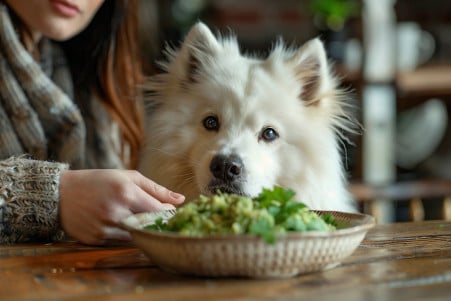Can Dogs Eat Ranch? Unveiling the Risks of Feeding Fido Condiments
20 February 2024 • Updated 18 February 2024

Ranch may be delicious to the human palate, but could it be dangerous to our furry friends? Dogs cannot eat ranch because it contains garlic and onions, both of which are toxic to dogs and can cause anemia. In addition, the high fat and salt content in ranch can cause digestive upset and obesity in dogs, and even a small amount can be detrimental to a dog’s health.
In order to better understand the risks and keep our pets safe, we’ll look at veterinary knowledge and nutritional research to get a better sense of what a dog’s diet should look like.
We’ll specifically look at what happens when dogs eat ranch dressing, including what we know about the toxic ingredients, lactose intolerance, and the impact of high-fat foods on dogs. By looking at these different studies, we hope to give a comprehensive view of the risks and recommendations of giving dogs human condiments like ranch.
Can dogs eat ranch?
The Toxic Truth Behind a Tasty Topping: The Ingredients in Ranch Dressing
While ranch dressing is a popular choice for many people, it hides a toxic truth for dogs. Some of the main ingredients, like garlic and onions, contain compounds that are poisonous to dogs, including N-propyl disulfide and thiosulfate.
According to PetMD, N-propyl disulfide in onions causes oxidative damage to red blood cells, which causes them to rupture, a condition called hemolysis. This can lead to a severe form of anemia, which can cause organs to become oxygen-deprived and potentially lead to organ failure.
Thiosulfate, which is found in garlic, also causes oxidative damage to red blood cells and decreases the amount of oxygen that gets to a dog’s tissues, which can cause weakness and lethargy, according to Purina. As a result, eating ranch dressing can cause serious health issues in dogs, including vomiting, diarrhea, abdominal pain, and pale gums, according to VCA Animal Hospitals.
If a dog eats ranch dressing or any other food that contains these toxic ingredients, it’s important to get them to a vet right away. You should not try to induce vomiting at home. Instead, a vet may treat the dog with activated charcoal, IV fluids, or even a blood transfusion.
As we think about our pet’s safety, it’s important to make sure that we keep these popular human foods out of their reach and stay on the lookout for any signs of trouble.
Got Milk? The Truth About Lactose Intolerance in Dogs
Ranch dressing, a common condiment that contains buttermilk, is one of the dairy products that dogs should avoid. Lactose intolerance is a condition that results from a lack of lactase, the enzyme that breaks down lactose, the sugar in milk.
As an article by Rover notes, dogs’ lactase production decreases after they are weaned, which means that they are less able to handle dairy products. Symptoms of lactose intolerance in dogs include diarrhea, vomiting, bloating, and gas.
On the other hand, if a dog is allergic to dairy, which is an immune system response to the proteins in milk, the reaction can be much more severe and include hives, swelling, and even anaphylaxis. VCA Animal Hospitals points out that it is important to get the right diagnosis and treatment by differentiating between food intolerance and food allergy.
If dog owners want to give their pets a treat that is similar to a dairy product but is safe for them to eat, they can look for lactose-free products that are made specifically for dogs or even dog probiotics, such as FortiFlora.
By choosing products that are made for dogs, pet owners can make sure that their pets can enjoy their treats without experiencing the negative side effects of dairy.
In addition to dairy, it’s also important to think about the amount of fat in a dog’s diet and how it can affect their well-being.
The Dangers of Too Much Fat in Your Dog’s Diet
Ranch dressing, because of its high-fat content, can lead to a number of health issues in your dog, including obesity and pancreatitis. While fat is an important part of a dog’s diet, too much of it can cause a number of health problems.
According to the Clinical Nutrition Service at Cummings School, fat has more calories per gram than proteins or carbohydrates, and this can lead to rapid weight gain and other health issues in dogs who eat a high-fat diet.
Symptoms of a high-fat diet can include gastrointestinal upset, lethargy, and obesity. While these symptoms may not be immediate, they can lead to more serious issues like pancreatitis. This is because many high-fat foods can cause pancreatitis, which is an extremely painful and potentially life-threatening inflammation of the pancreas that requires immediate medical attention, according to Jörg M. Steiner in a review in PMC.
It’s important to make sure that your dog’s diet is well-balanced. A low-fat diet, especially in dogs with certain health issues or a history of pancreatitis, can help ensure that they stay healthy.
In her article on fatty diets for dogs, Dr. Jan Huntingford explains that feeding dogs smaller, more frequent meals and making sure that they eat a well-balanced diet is the best way to prevent pancreatitis.
For those looking for low-fat alternatives to ranch dressing, it’s best to stick with dog-specific treats or make your own snacks at home with ingredients that have been approved by your vet to make sure that your dog doesn’t suffer from the hidden dangers of high-fat foods.
Sodium and Preservatives in Ranch: Potential Dangers for Dogs
While the saltiness of ranch dressing may be appealing to pet parents, it’s important to be mindful of the sodium content. While salt is an important part of a dog’s diet and helps maintain electrolyte balance, too much salt can lead to salt toxicosis, or hypernatremia—elevated sodium levels in the blood.
Signs of salt poisoning in dogs, per the Pet Poison Helpline, include vomiting, diarrhea, and lethargy, and in more severe cases, tremors, seizures, and even death. Salt poisoning is treated with hospitalization and intravenous fluids, which demonstrates the severity of the condition.
In addition to the potential dangers of salt, the preservatives in ranch dressing can also be problematic for dogs. While preservatives help ranch last longer for human consumption, they can lead to additional health problems for dogs. While the effects of preservatives on dogs are less well-researched than the effects of salt, these artificial additives could lead to negative side effects.
To avoid potential health problems from sodium and preservatives, pet parents should make sure their dogs are eating pet-safe foods and have access to fresh water. Limiting your dog’s exposure to high-sodium foods and making sure they are well-hydrated are both important preventive measures, according to the Animal Emergency Service. It’s also important for pet parents to be aware of potential dangers in human foods and opt for dog-friendly treats instead.
Final Thoughts: Why Dogs Shouldn’t Eat Ranch
In summary, ranch dressing is not safe for dogs because of its harmful chemicals, dairy, fat, salt, and preservatives. These ingredients can lead to a number of health problems in dogs, including anemia from garlic and onions, stomach issues from lactose intolerance, obesity and pancreatitis from fat, and salt poisoning. Good dog owners know that many human foods are not good for dogs.
It’s important to stress the importance of a dog-appropriate diet to avoid these issues. Making sure that dogs are eating food that is made for their specific needs is important to keeping them healthy.
When we know and respect the dietary needs that are important for their health, we are showing that we care for them. As important members of our households, we need to make sure that we are keeping them safe from the issues that can come from eating human foods like ranch.


